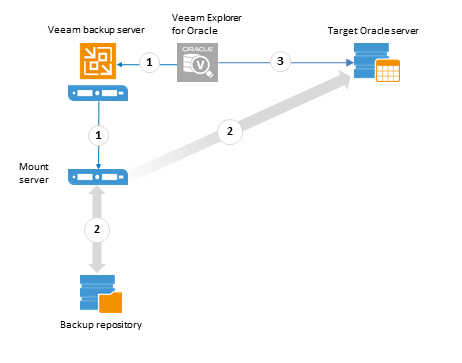Veeam Explorer for Oracle is installed together with Veeam backup server and management console or with the remote console. The basic procedures of restoring Oracle database with Veeam Explorer for Oracle are very similar for restore to current restore point and for restore to point in time or selected transaction.
Restore workflow is generally as follow:

- A user starts Veeam Explorer for Oracle using Veeam Backup & Replication console. Veeam Explorer obtains Oracle hierarchy information (see the next section for details) and presents it to user who then utilizes Veeam Explorer to:
- Select the database to restore
- Specify target location (original or another server) and settings required to access that server
- Invoke the 'Restore' command (through 1-Click Restore or restore wizard)
- The ‘Restore’ command initiates mount of Oracle VM file system from the backup stored in the repository to the Oracle server. Mount is performed using a machine where Veeam Mount Service runs (here it is the local machine hosting Veeam Explorer for Oracle). Typically, production Oracle server is used as a mount target. When a VM is mounted to the specified server, a corresponding folder is created on it:
- C:\VeeamFLR folder on Windows system
- /tmp/Veeam.Mount.XXX on Linux system
- Veeam utilizes native Oracle Recovery Manager (RMAN) to perform database restore operations. For that, it communicates database file paths and other necessary information to RMAN. After database files are restored (database is ‘re-created’) on the target Oracle server, it becomes ready for use.
|
If a user follows restore scenario that requires log replay, this operation is performed by Veeam Explorer for Oracle on target server. |
Obtaining Database Information from VM Backup
To present Oracle database hierarchy to user, Veeam Explorer uses different ways of retrieving application-specific information from image-level backup:
- If application-aware image processing is enabled in the Guest Processing settings of a backup job, then Veeam Explorer can obtain application-specific Oracle database information from Oracle VM backup metadata. For that, Veeam Explorer communicates with Veeam backup server that keeps this information in the Configuration database.
- If application-aware image processing is disabled in the Guest Processing settings of a backup job (a crash-consistent backup is created), then Veeam Explorer will need a staging Oracle server to mount selected image-level Oracle VM backup (with the databases and redo logs) to that staging server and collect the necessary information through guest scan and Oracle infrastructure analysis.
Using application information retrieved from backup, Veeam Explorer displays Oracle hierarchy in its navigation pane where you can select the database to be restored and start 1-Click Restore or Restore wizard.
- To create a mount point on Microsoft Windows machines, Veeam Backup & Replication uses the iSCSI protocol. The remote machine (original VM) or staging server acts as an iSCSI initiator. The machine on which the Veeam Explorer runs acts as an iSCSI target. The iSCSI mount point is non-persistent — it is created only for duration of the restore process.
- To create a mount point on Linux VMs (for Oracle running on Linux), Veeam Backup & Replication uses fuse.







